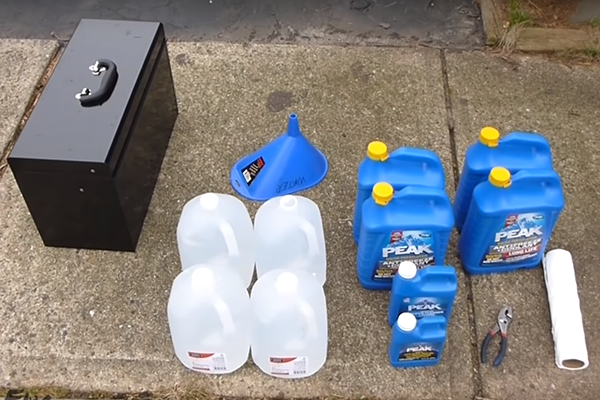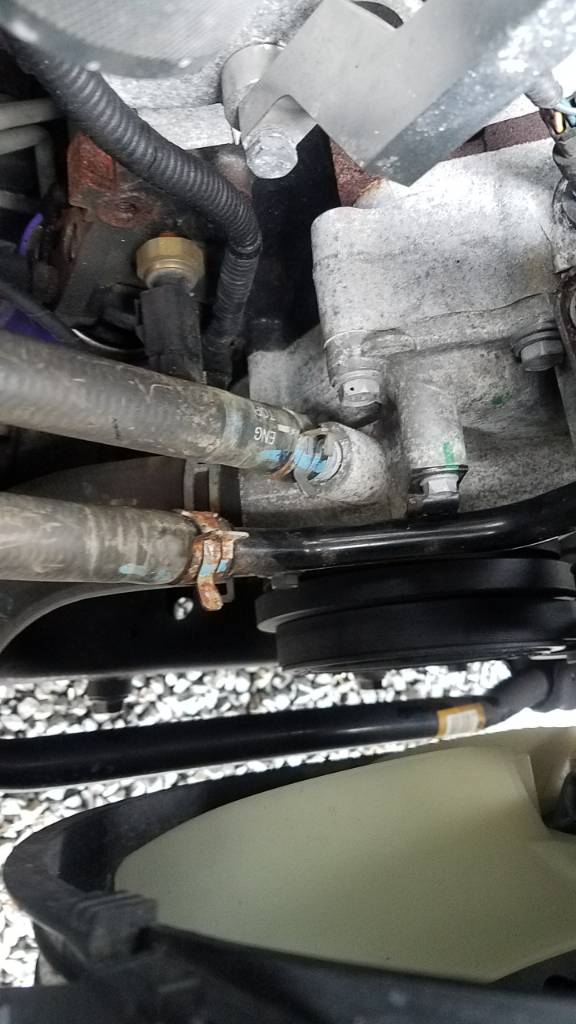
It is necessary to learn how to flush and fill the coolant in your truck. Keep your radiator, heater core, and engine clean. Flushing your coolant is good for the cooling system to prevent rust and to prevent your car from overheating. I would recommend doing a flush of the cooling system every 5 years if you’re planning on keeping the truck for any length of time. The steps I outline in this writeup involve flushing the cooling system with distilled water but if you decide do a radiator drain and fill with the proper coolant every 2-3 years, flushing with water isn’t necessary IMO.
Parts:
- A spill-proof funnel for adding coolant and bleeding air out of the system. Makes for very little mess.
- 10+ gallons of DISTILLED water
- 3 gallons of Mopar concentrated coolant. (I recommend the concentrate because it’s easier to get a 50/50 coolant mix. Plus it’s essentially the same price as the premixed Mopar coolant so why pay for water? )
- 1/4″ hose for attaching to the radiator petcock drain. It makes for less mess.
- Rags or shop towels
Tools:
- 3/8″ allen socket
- 1/4″ allen socket
- Torque wrench that goes as low as 10 ft/lbs
- 14mm socket for the block drain plug
- 13mm socket for the thermostat housing bolts
- Pliers for the hose clamps
- Antifreeze tester
1, Start on a cool or better yet cold engine. A hot engines cooling system is under pressure and can burn you!
2, Drain the radiator: Take the radiator cap off and set it aside. Attach the 1/4″ hose to the drain nipple and feed it into a container. Rotate the petcock counterclockwise using the 3/8″ allen socket until it opens completely. You will hear coolant start draining into your container. The radiator holds about 2 gallons of coolant so plan your containers accordingly.
3, Next go to the thermostat housing. This would be a great time to change your thermostat since you will be taking the housing off the water pump. Loosen the bolts on the water pump and remove the housing from the water pump. Remove the bleeder plug next to the thermostat housing using the 1/4″ allen socket. Pry the outer gasket off the thermostat and reinstall the housing without the thermostat but with the gasket in place. This will ensure water flushes through the entire block.
4, Locate the heater core hoses at the bottom of the water pump. Remove both from the water pump noting where they attach to. Be ready with a drain pan under it because all the coolant in the heater core will flow out. At this point I took 12psi of compressed air to one heater core hose to completely blow out any remaining coolant. This isn’t really necessary as most of the coolant flows out on its own but it doesn’t hurt to do. DO NOT USE MORE THAN 15psi of air! Replacing the heater core is a big job that involves removing the dash and HVAC assembly.
5, Remove the lower radiator hose and allow anything left to drain into a drain pan.
6, Next comes the fun part, the block drains. The passenger’s side block drain is perfectly visible. Remove it slowly and allow it to drain slowly. If the whole plug is removed, you will take a shower in coolant. Trust me, not fun. The driver’s side block drain is perfectly behind the starter and front diff bracket. I didn’t have any tools that would fit in there at that angle, so I wasn’t able to drain the driver’s side of the block. If anyone can figure that out, please post what tools you used!
7, Once you’re satisfied that all the old coolant is out (with the exception of the driver’s side of the block) reconnect the heater core hoses, lower radiator hose, and put in the passenger’s block drain plug. Leave the bleeder plug on the thermostat housing out for now.
8, Now is the time to attach the spill proof funnel to the radiator. Fill the radiator with distilled water until it comes out of the thermostat bleed plug hole. It’s going to take close to 2 gallons of water before that happens. Once it comes out put the bleeder plug back in.
9, Start the truck and let it run at idle. Make sure the hvac temp is on heat. It will immediately suck the water down inside the radiator. Continue filling the radiator with distilled water until its full. It will bubble and spatter water out of the funnel as the air bleeds out of the system. When I did this my truck never got above 130* because there was no thermostat installed.
10, Rev the engine to 2000RPMs for a minute or so several times and then shut the truck off.
11, Begin draining the water out of the radiator just like before as well as the heater core hoses, lower radiator hose, and remove the thermostat housing bleeder plug again. Let everything drain and then move to the passenger’s side block drain. Allow that to drain just like before and the driver’s side as well if you can get it out. Once you’re satisfied with how much water is drained out, put the drain plug back, bleeder plug back, and reattach all the hoses. Fill again with distilled water, run the engine like before, and drain again. If the water is clear you’re done flushing. If not repeat the drain and fill procedure until the water is clear.
12, Once you’re satisfied with the flushing process, apply thread sealant to the block drain(s) and install them back into the block. Remove the thermostat housing and remove the gasket you put in earlier. Reinstall it onto the thermostat and reinstall the thermostat. Torque the bolts to 10ft/lbs. Leave the thermostat bleeder plug out for now. Reattach all the hoses. There is still some distilled water in the system so if you only put premixed 50/50 coolant in, it will be diluted to a point and you won’t have the correct freeze protection. I mixed 3 gallons of 50/50, so 1.5 gallons of Mopar concentrated coolant. I used this for the initial fill. Just like before, pour 2 gallons into the radiator until it comes out the thermostat bleeder port. Apply thread sealant to the thermostat bleeder plug and reinstall it.
13, Start the truck and let it idle. Fill the radiator with coolant until its full. Let the truck heat up to 203* (or less if you have a different thermostat) so the thermostat will open. When it does it will suck all the coolant down. Refill with 50/50 mix until the radiator is full. Check to make sure there’s heat in the cab. Once the radiator is full and its mostly done bubbling, remove the spill proof funnel and put the radiator cap on. Check for leaks at all the hoses and drain plugs. Go for a short drive to circulate and mix the coolant. When you get back use the antifreeze tester check the freeze and boil over protection. If you were able to drain the driver’s side block you should be pretty close to 50/50. Mine was a little low because I didn’t drain the driver’s side of the block. I ended up draining 2 quarts out of the radiator and putting 2 quarts of straight concentrate coolant in. Went for another drive and retested my freeze protection and it was at -34* which is a 50/50 mix.
14, Check the coolant overflow and fill it accordingly with 50/50.
15, That’s it you’re done! If I missed anything or anyone has a better procedure, please post it up.
Heater core hoses on the water pump:

Radiator petcock:

Passengers side block drain

View of the passenger’s side block drain plug from the wheel well.

Best view I can get of the driver’s side block drain

Removing the thermostat gasket temporarily.

